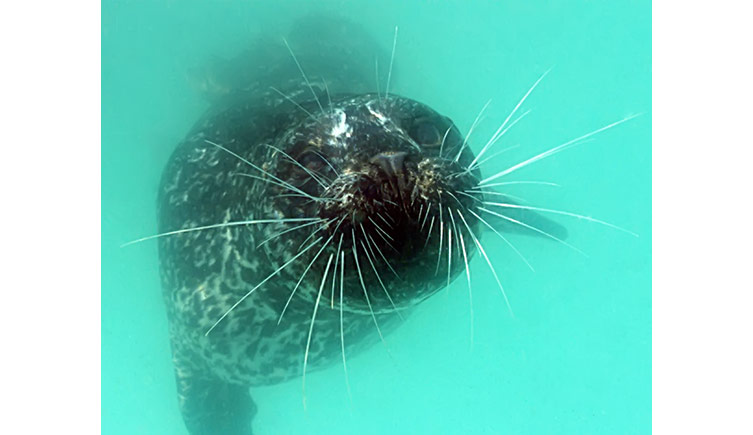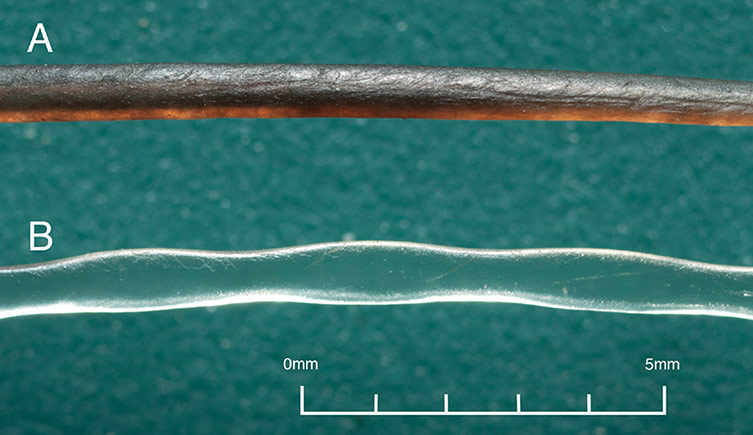Seals have highly sensitive whiskers that enable them to hunt effectively even in poor visual conditions. Their specially shaped whiskers can detect the disturbances left by other creatures moving through the water, even while they are moving themselves.
If you’re a seal, finding food can be a challenge. Harbour seals, for example, live in coastal waters that can get heavily churned up by tides and storms. This makes the water very murky and it can be hard for the seal to see its prey.
Dr Ben Burville is an underwater cameraman and visiting researcher at Newcastle University who has documented seal life for decades. He knows first-hand the challenging conditions the seals face. 'Depending on what the weather is like, if there have been storms for example, sometimes your visibility is limited to one foot in front of your face. '
But even without vision, it seems a seal can be successful. 'Seals have big eyes, which are often prone to injury or infection. But I've seen mothers who are blind in both eyes who can function effectively and still raise pups.'
Scientists have discovered that seals don't just rely on their large eyes and sensitive hearing when hunting. Their experiments have shown that, even when blindfolded and wearing headphones, a seal can find its quarry. The seal's secret weapon are its whiskers.
What are whiskers for?
Unlike humans, most mammals have whiskers. These thick wiry hairs are packed with nerve endings at the base, making them very sensitive to any movement. While whiskers can be used to touch and examine something, a marine animal like a seal can also detect vibrations in the water.

A harbour seal in underwater tracking mode, with its whiskers held erect. Image © Christin T. Murphy et al. (2013). CC BY 3.0 Effect of Angle on Flow-Induced Vibrations of Pinniped Vibrissae;PLoS ONE. 8 (7): e69872. Image cropped
When tracking underwater vibrations, the seal pulls its whiskers erect so that they are held away from it face. A swimming fish causes swirling disturbances in the water. A seal's whiskers can detect these hydrodynamic trails and track the fish's path, giving the seal the direction of the fish, distance from the fish and even an indication of the fish's size.
Ben is convinced that seals can control the sensitivity of their whiskers. 'Sometimes they come and play with me and they will use their whiskers to feel my face. I'm pretty sure they must have the ability to tune their sensitivity.'

A fish leaves a trail of eddies in the water as it swims, which the seal can use to track it by
Why a seal's whiskers are wavy
Mammals generally have regularly shaped, round whiskers. But nearly all seal species have whiskers that are irregular and wavy.
The irregular shape of the whisker holds it steady as the seal swims. The whisker only vibrates in response to hydrodynamic trails.

The top whisker (A) belongs to a California sea lion, while the bottom wavy whisker (B) is from a harbour seal. Image © Christin T. Murphy et al. (2013). CC BY 3.0 Effect of Angle on Flow-Induced Vibrations of Pinniped Vibrissae;PLoS ONE. 8 (7): e69872.
More to discover
Scientists' experiments have shown that seals are sensitive enough to detect fish 100m away. Researchers are continuing to investigate the seals' secrets, trying to understand how the seal converts whisker vibration into an understanding of where its target is located.They hope they can use their discoveries to create improved artificial sensor systems for ships, submarines and underwater robots.
Ben also thinks that the seals have more whisker tricks to uncover. 'As well as the whiskers detecting eddies, it's possible they have an active function as well. I've seen the seals vibrate their whiskers, so perhaps they can send out signals and receive them.'

British wildlife
Find out about the plants and animals that make the UK home.




Don't miss a thing
Receive email updates about our news, science, exhibitions, events, products, services and fundraising activities. We may occasionally include third-party content from our corporate partners and other museums. We will not share your personal details with these third parties. You must be over the age of 13. Privacy notice.
Follow us on social media